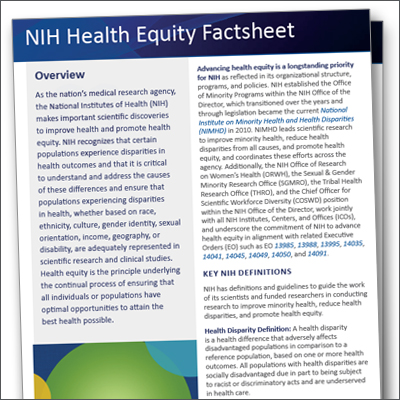What Is Health Equity?
Health equity is the principle underlying the continual process of ensuring that all individuals or populations have optimal opportunities to attain the best health possible. Applying the principle of health equity requires that barriers to promoting good health are removed and resources are allocated among populations and/or communities proportional to their need(s).
As the nation’s medical research agency, the National Institutes of Health (NIH) makes important scientific discoveries to improve health and promote health equity. The NIH Health Equity Factsheet introduces NIH's health equity strategy, research priorities, and related actions and impacts.
How is health equity integrated into research and practice?
Integrating health equity in research and clinical practice applies frameworks that center on fairness, opportunity, quality, and social justice to promote well-being and health.
Health equity efforts, at their outset, should carefully consider the unintended consequences that disadvantaged groups might experience from specific policies, research, programs, intervention, or treatments—and reassess throughout implementation. Assuring sustainable health equity often involves changes in laws, policies, processes, norms, values, resource allocation, and power structures (both intentional and unintentional) that affect access to healthcare, employment, education, wealth, public safety, housing, safe green spaces, and other social determinants of health.
Can health equity be measured?
Health equity is not a specific outcome or end point but includes measurements across factors that influence health, such as structural drivers, community context, and healthcare. The common metric used to assess movement toward health equity is a reduction in health disparities. However, measuring health equity moves beyond decreases in health disparities, to measuring the attainment of aspirational goals to achieve the best possible health for all populations.
Simply measuring health disparities neglects the determinants of health, root causes, or systems that directly or indirectly cause health disparities. Health equity metrics should focus on describing, assessing, and continuously evaluating the degree of fairness and social justice embedded within structures, programs, policies, and processes of systems.
Applying a health equity lens in science requires an intentional effort to ensure that research is designed explicitly to promote fairness, opportunity, quality, and social justice in access, interventions or treatments, and outcomes.
What are examples of efforts to promote equity in health, healthcare, and research?
- System-wide development and implementation of culturally appropriate interventions and a healthcare workforce that practices cultural humility
- Access to high quality healthcare irrespective of ability to pay
- Free or reduced cost lunch in schools based on a household income sliding scale
- Access to safe and high-quality green spaces (e.g., for physical activity) in all neighborhoods
- Provision of access to transportation to healthcare or research settings
- Provision of appropriate technology for telehealth visits at no cost for persons with lower socioeconomic status, as well as training on equipment use
- Supports to facilitate medication access and adherence
- Targeted health communication and health literacy, screening, and treatment linkage efforts in populations experiencing heightened disease burden
- Meaningful engagement of community collaborators and end-users at each stage of program development or research design, implementation, and dissemination
Page updated March 27, 2024


















